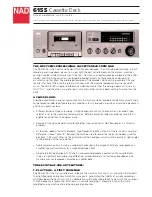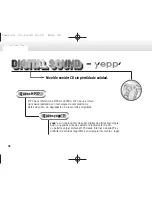
1-20 (No.YD051)
4.2.4 A/C head phase (X-value)
(1) Play back the alignment tape (A1).
(2) Apply the external trigger signal to D.FF (E), to observe the
V.PB FM waveform at the measuring point (D).
(3) Set the VCR to the manual tracking mode.
(4) Loosen the screws (4) and (5), then set the Roller driver to
the innermost projected part of the A/C head. (See Fig. 4-
2e.)
(5) Rotate the roller driver so that the A/C head comes closest
to the capstan. From there, move the A/C head back grad-
ually toward the drum until the point where the FM wave-
form is maximized for the second time, and then
tighten the screws (4) and (5) temporarily.
(6) Play an alignment tape (A2) and set to the manual-tracking
mode.
(7) Fine-adjust A/C head base position to maximize the FM
waveform, and then tighten the screws (4) and (5) firmly.
(8) Play alignment tapes (A1) and (A2) and confirm that the FM
waveforms are maximized when the tracking is at the cen-
ter position.
Fig.4-2e
Fig.4-2f
4.3 Electrical adjustment [VHS SECTION]
Note:
The following adjustment procedures are not only necessary
after replacement of consumable mechanical parts or board
assemblies, but are also provided as references to be referred
to when servicing the electrical circuitry.
In case of trouble with the electrical circuitry, always begin a
service by identifying the defective points by using the measur-
ing instruments as described in the following electrical adjust-
ment procedures. After this, proceed to the repair,
replacement and/or adjustment. If the required measuring in-
struments are not available in the field, do not change the ad-
justment parts (variable resistor, etc.) carelessly.
4.3.1 Servo circuit
4.3.1.1
Switching point
(1) Play back the signal (A1) of the alignment tape (A2).
(2) Apply the external trigger signal to D.FF (E) to observe the
VIDEO OUT waveform and V.PB FM waveform at the mea-
suring points (D1) and (D2).
(3) Set the VCR to the manual tracking mode.
(4) Adjust tracking so that the V.PB FM waveform becomes
maximum.
(5) Set the VCR to the Auto adjust mode by transmitting the
code (F) from the Jig RCU. When the VCR enters the stop
mode, the adjustment is completed.
(6) If the VCR enters the eject mode, repeat steps (1) to (5)
again.
(7) Play back the alignment tape (A2) again, confirm that the
switching point is the specified value (G).
Fig.4-3a Switching point
4.3.1.2
Slow tracking preset
Signal
(A1)
(A2)
• Alignment tape(SP, stairstep, PAL) [MHPE]
• Alignment tape(LP,stairstep,PAL) [MHPE-L]
Mode
(B)
• PB
Equipment
(C) • Oscilloscope
Measuring point (D) • TP106 (PB. FM)
External trigger (E)
• TP111 (D.FF)
Adjustment part (F)
• A/C head base [Mechanism assembly]
Specified value (G) • Flat V.PB FM waveform
Adjustment tool (H) • Roller driver [PTU94002]
Head base
Roller driver
To the capstan
To the drum
Toward the capstan
Toward the drum
Screw (5)
Screw (4)
A/C head
Alignment tape
[SP, stairstep]
played with the
SP head
Alignment tape
[EP(LP), stairstep]
played with the
EP(LP) head
Drum side
Control head position
Capstan side
X-value adjustment point
Maximum
Waveform output
Signal
(A1)
(A2)
• Stairstep signal
• Alignment tape(LP,stairstep,PAL) [MHPE-L]
Mode
(B)
• PB
Equipment
(C) • Oscilloscope
Measuring point (D) • VIDEO OUT terminal (75 ohm terminated)
• TP106 (PB. FM)
External trigger (E)
• TP111 (D.FF)
Adjustment part (F)
• Jig RCU: Code “43-5A”
Specified value (G) • 6.5±0.5H
Adjustment tool (H) • Jig RCU [PTU94023B]
Signal
(A1)
(A2)
• Ext. input
• Color (colour) bar signal [PAL]
Mode
(B1)
(B2)
• VHS SP
• VHS LP
Measuring point (D) • TV-Monitor
Adjustment part (F)
• Jig RCU: Code “43-71”or “43-72”
Specified value (G) • minimum noise
Adjustment tool (H) • Jig RCU [PTU94023B]
V.sync
Trigger point
Switching point
V. rate
















































